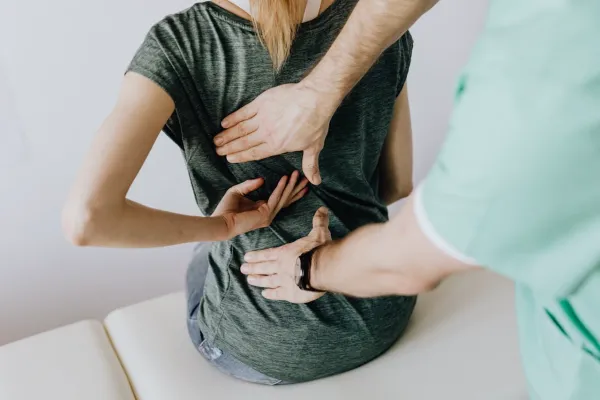A 2024 report by the Indian Spinal Injuries Centre (ISIC) estimated that nearly 80% of Indians experience back pain at least once in their lifetime, and over 10 million new spine-related cases are reported every year. Orthopaedic experts also warn that the problem is affecting younger demographics faster than ever. A 2023 AIIMS study found that one in five patients with chronic back pain was under 30 years of age.
Lifestyle factors such as prolonged sitting, poor posture, and excessive mobile or laptop use are accelerating , a condition once confined mainly to older adults.
As Dr Rajesh Parasnis, Consultant Orthopaedic and Spine Surgeon at Ruby Hall Clinic, Pune, explains, the modern lifestyle has made spine issues "an everyday health challenge that we can no longer ignore." So, on World Spine Day 2025, here are the five most common spine issues affecting Indians today, and simple precautions that can help protect spinal health before it's too late.
1. Slip Disc (Herniated Disc)
The condition known as a herniated or slipped disc occurs when the soft inner part of a spinal disc bulges or breaks through the outer layer, irritating nearby nerves. It often manifests as back pain radiating to the arms or legs, sometimes accompanied by numbness or tingling. This problem is particularly common among people who sit for long hours or lift heavy objects incorrectly.
Doctor's Advice: "Keep your back straight, bend your knees (not your back) when lifting, and maintain a neutral spine position," advises Dr Parasnis. "The most effective preventive measure is to strengthen your core muscles through regular exercise."
2. Cervical And Lumbar Spondylosis
Spondylosis refers to degeneration of the spine due to wear and tear of the vertebrae and discs. With increased computer and smartphone use, symptoms such as neck stiffness, shoulder pain and tingling in the arms are now being reported by people in their 20s and 30s.
Doctor's Recommendation: "Use ergonomic chairs, keep your computer screen at eye level and take short breaks every 30-40 minutes to stretch," says Dr Parasnis. "Exercises that strengthen the neck and shoulder muscles can prevent long-term damage."

Photo Credit: Pexels
3. Sciatica
Sciatica occurs when the sciatic nerve, which runs from the lower back down the legs, becomes compressed or irritated. It causes sharp, burning pain that often worsens with sitting or bending.
Doctor's Advice: "Maintain a healthy weight and avoid sitting in one position for too long," advises Dr Parasnis. "Engage in low-impact activities such as walking or swimming to keep your spine flexible and reduce stiffness."
4. Spinal Stenosis
Spinal stenosis is the narrowing of the spinal canal, which compresses the nerves and causes pain, numbness or weakness in the legs. While more common with age, it can also appear earlier due to poor posture or disc degeneration.
Doctor's Advice: "Regular stretching, yoga and physical activity can delay spinal wear and tear," says Dr Parasnis. "Early physiotherapy and posture correction can help manage symptoms and may prevent the need for surgery later."
5. Postural Back Pain
Postural has become one of the most frequent complaints, especially among people working long hours from home. Poor seating, slouching over laptops or mobile screens and lack of movement lead to chronic pain and muscle imbalances.
Doctor's Advice: "Arrange your workstation ergonomically. Sit upright, keep your feet flat on the floor and take short breaks every hour," advises Dr Parasnis. "Simple exercises like shoulder rolls and back stretches go a long way in maintaining spinal health."
Take Your Spine Seriously
Spinal health is integral to overall wellbeing. Back or neck pain should never be ignored or self-medicated. Persistent , tingling, or limb weakness are warning signs that require medical attention. Early diagnosis and lifestyle changes can prevent minor spine problems from developing into chronic or disabling conditions.
As Dr Parasnis stresses, prevention is always better than cure: "Spine care is about daily discipline - good posture, regular exercise and timely medical consultation can help preserve your spinal health for years to come."
Disclaimer: This content including advice provides generic information only. It is in no way a substitute for a qualified medical opinion. Always consult a specialist or your own doctor for more information. NDTV does not claim responsibility for this information.
References:
1. World Health Organization (WHO). Low Back Pain: Leading Cause of Disability Worldwide. 2023.
2. Indian Spinal Injuries Centre (ISIC) Annual Report 2024.
3. AIIMS (New Delhi) Research Report on Spinal Health in Young Adults, 2023.
4. The Lancet Rheumatology (2022). Global Burden of Musculoskeletal Disorders.

 Photo Credit: Pexels
3. Sciatica
Sciatica occurs when the sciatic nerve, which runs from the lower back down the legs, becomes compressed or irritated. It causes sharp, burning pain that often worsens with sitting or bending.
Doctor's Advice: "Maintain a healthy weight and avoid sitting in one position for too long," advises Dr Parasnis. "Engage in low-impact activities such as walking or swimming to keep your spine flexible and reduce stiffness."
4. Spinal Stenosis
Spinal stenosis is the narrowing of the spinal canal, which compresses the nerves and causes pain, numbness or weakness in the legs. While more common with age, it can also appear earlier due to poor posture or disc degeneration.
Doctor's Advice: "Regular stretching, yoga and physical activity can delay spinal wear and tear," says Dr Parasnis. "Early physiotherapy and posture correction can help manage symptoms and may prevent the need for surgery later."
5. Postural Back Pain
Postural has become one of the most frequent complaints, especially among people working long hours from home. Poor seating, slouching over laptops or mobile screens and lack of movement lead to chronic pain and muscle imbalances.
Doctor's Advice: "Arrange your workstation ergonomically. Sit upright, keep your feet flat on the floor and take short breaks every hour," advises Dr Parasnis. "Simple exercises like shoulder rolls and back stretches go a long way in maintaining spinal health."
Take Your Spine Seriously
Spinal health is integral to overall wellbeing. Back or neck pain should never be ignored or self-medicated. Persistent , tingling, or limb weakness are warning signs that require medical attention. Early diagnosis and lifestyle changes can prevent minor spine problems from developing into chronic or disabling conditions.
As Dr Parasnis stresses, prevention is always better than cure: "Spine care is about daily discipline - good posture, regular exercise and timely medical consultation can help preserve your spinal health for years to come."
Disclaimer: This content including advice provides generic information only. It is in no way a substitute for a qualified medical opinion. Always consult a specialist or your own doctor for more information. NDTV does not claim responsibility for this information.
References:
1. World Health Organization (WHO). Low Back Pain: Leading Cause of Disability Worldwide. 2023.
2. Indian Spinal Injuries Centre (ISIC) Annual Report 2024.
3. AIIMS (New Delhi) Research Report on Spinal Health in Young Adults, 2023.
4. The Lancet Rheumatology (2022). Global Burden of Musculoskeletal Disorders.
Photo Credit: Pexels
3. Sciatica
Sciatica occurs when the sciatic nerve, which runs from the lower back down the legs, becomes compressed or irritated. It causes sharp, burning pain that often worsens with sitting or bending.
Doctor's Advice: "Maintain a healthy weight and avoid sitting in one position for too long," advises Dr Parasnis. "Engage in low-impact activities such as walking or swimming to keep your spine flexible and reduce stiffness."
4. Spinal Stenosis
Spinal stenosis is the narrowing of the spinal canal, which compresses the nerves and causes pain, numbness or weakness in the legs. While more common with age, it can also appear earlier due to poor posture or disc degeneration.
Doctor's Advice: "Regular stretching, yoga and physical activity can delay spinal wear and tear," says Dr Parasnis. "Early physiotherapy and posture correction can help manage symptoms and may prevent the need for surgery later."
5. Postural Back Pain
Postural has become one of the most frequent complaints, especially among people working long hours from home. Poor seating, slouching over laptops or mobile screens and lack of movement lead to chronic pain and muscle imbalances.
Doctor's Advice: "Arrange your workstation ergonomically. Sit upright, keep your feet flat on the floor and take short breaks every hour," advises Dr Parasnis. "Simple exercises like shoulder rolls and back stretches go a long way in maintaining spinal health."
Take Your Spine Seriously
Spinal health is integral to overall wellbeing. Back or neck pain should never be ignored or self-medicated. Persistent , tingling, or limb weakness are warning signs that require medical attention. Early diagnosis and lifestyle changes can prevent minor spine problems from developing into chronic or disabling conditions.
As Dr Parasnis stresses, prevention is always better than cure: "Spine care is about daily discipline - good posture, regular exercise and timely medical consultation can help preserve your spinal health for years to come."
Disclaimer: This content including advice provides generic information only. It is in no way a substitute for a qualified medical opinion. Always consult a specialist or your own doctor for more information. NDTV does not claim responsibility for this information.
References:
1. World Health Organization (WHO). Low Back Pain: Leading Cause of Disability Worldwide. 2023.
2. Indian Spinal Injuries Centre (ISIC) Annual Report 2024.
3. AIIMS (New Delhi) Research Report on Spinal Health in Young Adults, 2023.
4. The Lancet Rheumatology (2022). Global Burden of Musculoskeletal Disorders.